How to Get Rid OfVoles
47 min read Updated for October, 2019
Voles are often confused with mice due to their small, furry bodies and long tails. However, even though they’re sometimes called field mice, voles are actually in a different family of rodent than mice. These mammals can become can become a problem for homeowners due to their ability to destroy plants, dig elaborate burrows under homes, and even kill trees. What’s more, voles can reproduce at an alarming rate—one pair can produce up to 100 young per year—making them difficult to manage.
47 min read Updated for October, 2019
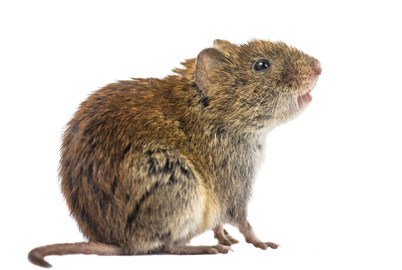
Vole Sounds
Similar to mice, voles emit a high-pitched chirp when communicating with others, however, most of their vocal sounds are on a frequency beyond the human hearing capacity. Even while burrowing and rustling while foraging, most of their sounds are far too quiet for humans to hear.
Vole Tracks
The tracks that voles make aren’t so much actual track prints as they are the tunnels and burrows they create. Their ‘runways’ are most obvious in the spring and into the summer where you will see furrows with a lack of grass and a rise of top soil by two to three inches and an inch or two wide.
Vole Poop
Vole poop are usually greenish-colored pellets found near the burrow entrances, are roughly three-sixteenths of an inch long and often include grass clipping or foliage remnants. As they age, the dropping turn from green to brown or gray.
Identify
Because they resemble gophers and mice so closely, voles may be tough to identify correctly. But learning their distinctive characteristics and getting a closer look can help you tell them apart from other rodents.
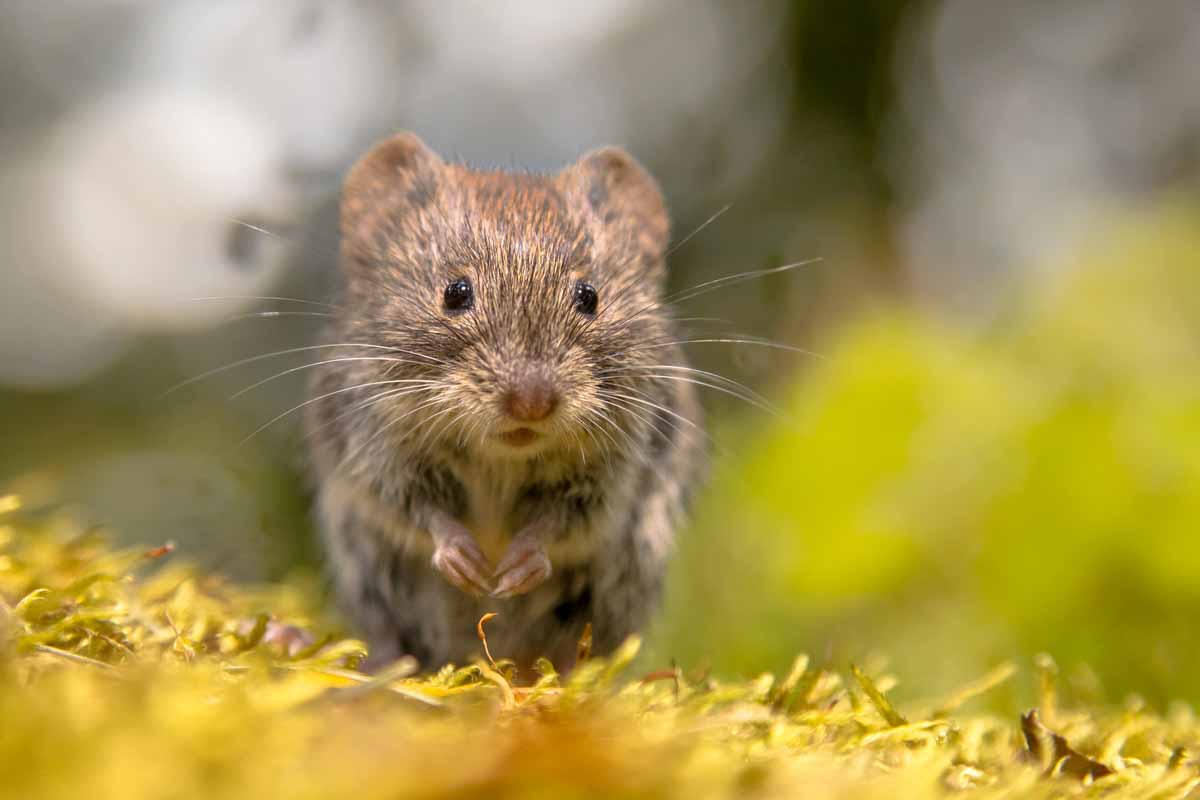
Physical Characteristics
Color:
Usually light brown or gray with a lighter underbelly
Tail:
Medium length, shorter than a mouse’s but longer than a mole’s, and covered in sparse fur
Body:
Slightly thicker and heavier than mice
Size:
Can reach between three and nine inches in length; most voles only weigh one or two ounces, although some species may be slightly heavier
Face:
Voles have blunter snouts than their pointy-faced cousin the mouse
Eyes and ears:
Vole eyes and ears are smaller than mice because they’ve evolved to spend more of their time underground
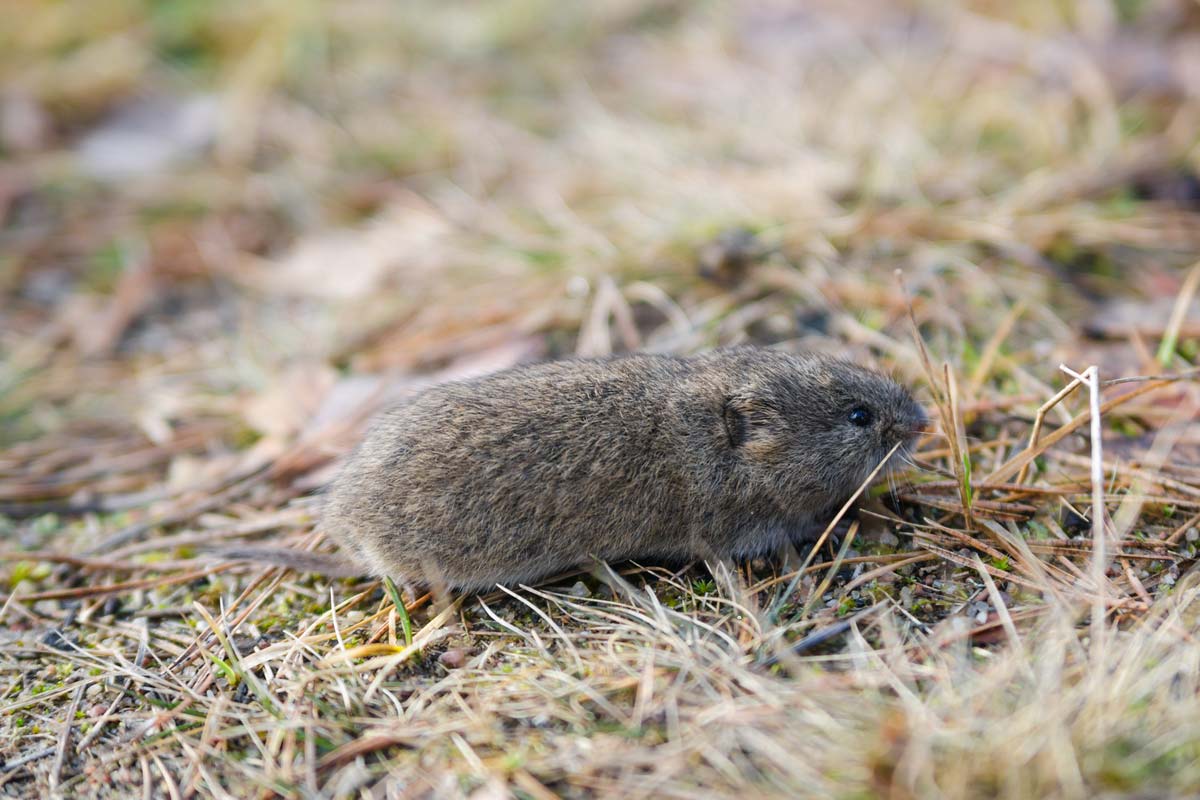
Behavior
Voles are similar to other burrowing animals, but they also have tendencies that make them unique. Here’s what you need to know about voles before creating a game plan for your yard.
- Voles are not picky about food; they’ll eat plants, tree bark, roots, tubers, or even dead animals or insects
- Voles are excellent burrowers just like moles and gophers, but they also spend substantial time foraging above ground
- Voles rely on ground cover, like leaves, stumps, and other debris to stay concealed above ground
- Voles can destroy trees by “girdling” them, or eating a ring of their bark and starving them of nutrients
- Unlike most other rodents, some species of voles are monogamous
- Voles are social creatures and often live in groups
- Voles can mate and reproduce multiple times a year
- Litters usually produce five to ten offspring
- Voles are active throughout the year and do not hibernate
- Most voles do not survive after than six months
- Voles do not often attempt to invade houses or buildings
- Like other rodents, voles store up nuts and other foods for the winter
Treating Your Property For Voles
Since vole populations can balloon so quickly, you’ll want to take a proactive approach if you start seeing them—or the damage they cause—in your yard. If you prefer not to trap the voles, you can always deploy a store-bought treatment method. Many of these come in the form of a spray or granular repellents and do not harm the animals.
If you prefer to use natural methods to control your vole population, there are still plenty of other options. Voles, like many rodents, dislike some odors and can be driven out when confronted with them. Here are a few DIY treatment ideas to get you started.
Castor Oil
This handy oil works on most burrowing rodents. Plus, it’s an all-natural derivative of castor beans. You may even have some in your house already since it’s also used for moisturizing dry skin and reducing acne. Making a castor oil solution and spraying it around your garden may help deter voles.
Capsaicin
Voles dislike spicy-smelling foods, so you may be able to fend them off with hot spices from your cabinet. One ingredient that may be particularly helpful is capsaicin, an oil that comes from hot peppers.
Pet waste
Voles have many natural predators, including cats and dogs. That means you can cause their droppings to scare voles away. Sprinkle some pet urine on your yard and voles will smell it, even from a distance. You can also purchase urine granules from some of the vole’s wild predators, which might be even more effective.
Garlic
Most rodents dislike the overpowering scent of garlic, so placing it inside the vole tunnel may send them scurrying away. You can also experiment with other strong odors, like onions or fish.
Vole Problem?
Voles are not picky about food; they’ll eat plants, tree bark, roots, tubers, or even dead animals or insects.
Habitat
Voles live in many different habitats and preference depends largely on the species. In general, voles gravitate toward areas with plenty of plant life and ground cover.
- Areas with high grasses or weeds that help them stay concealed
- Anywhere their favorite foods, like grasses, vegetables, roots, and tree bark, can be found
- Woodlands, open forests, fields near farmland, suburban areas with plenty of food
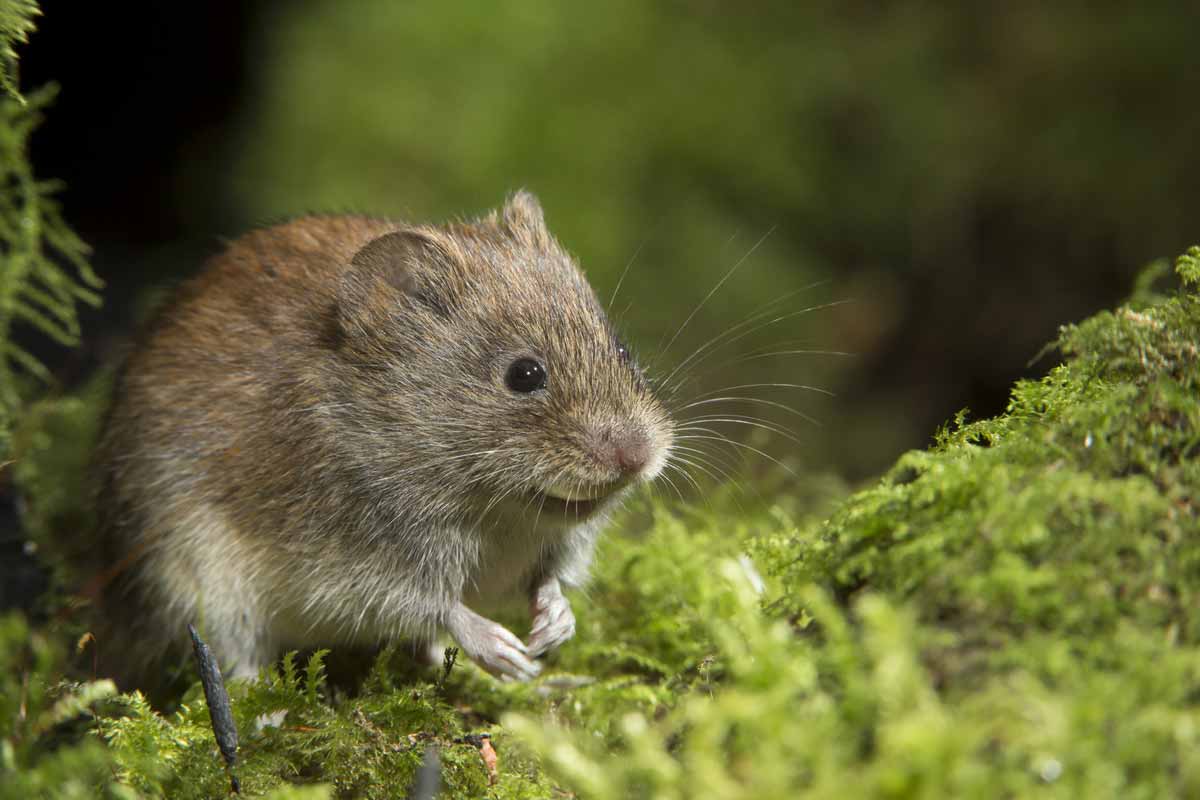
Voles can be found throughout most of the United States and Canada, and even as far North as Alaska.
Geography
Voles can be found throughout most of the United States and Canada, and even as far North as Alaska.
- The prairie vole is one of the most common species and covers much of the Great Plains
- Meadow moles can be found across most of the Northern U.S. and into Canada
- Pine voles are the most common species in the Southeast U.S.
- Long-tailed voles cover most of the Northwest U.S. and into British Columbia
Common Species
Voles are similar across species, but you can tell them apart with the right guide. Here’s what to look for when identifying your vole.
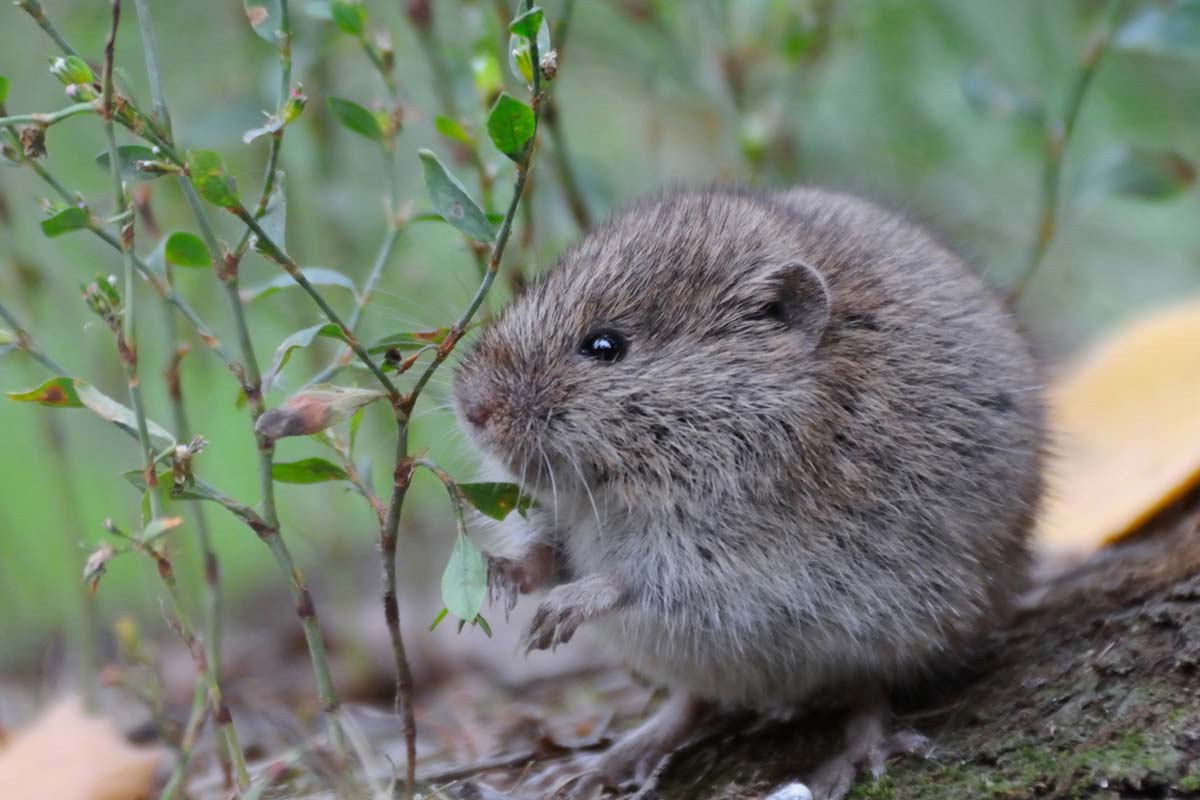
Prairie Voles
This common vole thrives in a dry climate that offers plenty of tall grasses to help them stay hidden when foraging.
Appearance
- Long brown or black fur; belly may be yellowish
- Under two ounces in weight
- Tan paws
Behavior
- Prairie voles often cut off grasses and plants, drag them back to the burrow, and then store them for colder months
- Can reproduce at any time of the year; will have more young if resources are plentiful
- Unlike many rodents, voles are monogamous, and fathers will stay to raise their young
- May eat tree bark in the winter to survive
- Tunnel systems may be established above ground in thick grasses or underground
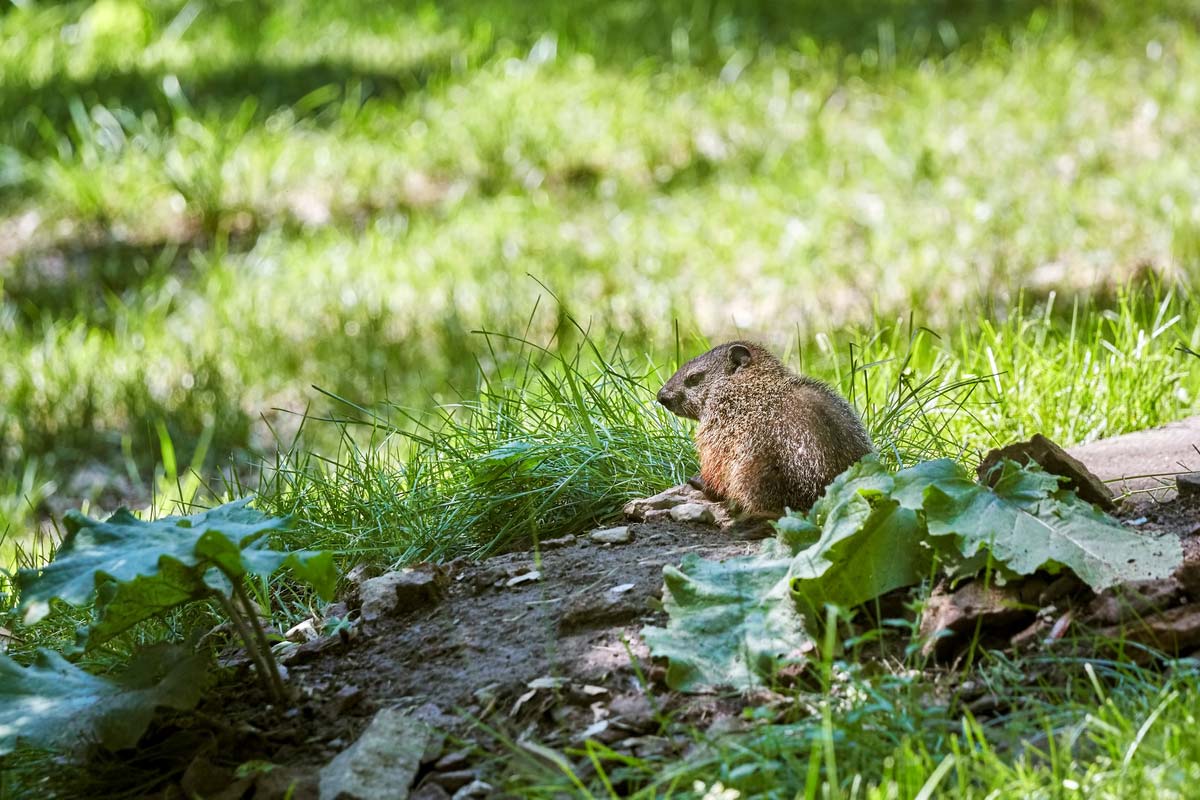
Meadow Vole
The Meadow Vole is another very common species of vole. It prefers colder climates than other species and is found throughout the Northern U.S. and Canada.
Appearance
- Dark brown with a whitish underbelly, although coloration can vary by geography
- Slightly longer tail than other species
- Usually weighs two ounces or less
Behavior
- Prefers a slightly damper habitat than other voles
- Can multiple at a rapid pace, producing up to 10 litters per year
- Mate with multiple partners; are not monogamous like other voles
- Covers more territory in the U.S. than any other vole

Long-Tailed Vole
The long-tailed vole stands out for its longer than average tail. As we mentioned earlier, the long-tailed voles are usually found on the Eastern side of North America.
Appearance
- Up to seven inches long with a three-inch tail
- Only weigh one or two ounces on average
- Fur is usually dark brown or mottled
Behavior
- Live at higher elevations and prefer to be close to water sources
- Unlike other voles, they don’t follow the same paths between burrows but wander freely
- Do not reproduce as often as other vole species, due in part to living in harsher climates
Common Locations
As you’ve probably gathered, voles can live in many different landscapes. Each species has adapted to a slightly different environment, which means these creatures can survive just about anywhere. In general, though, they look for a habitat with lots of lush plant life and plenty of ground cover to protect them from predators.
Voles have many predators, including owls, domestic pets, foxes, hawks, coyotes, etc.
Why They’re There
Because they adapt so well to different landscapes, it can be hard to isolate what, exactly, is drawing voles to your yard. So it can be helpful to think like a vole and determine what resources they look for when choosing a home.
Food
Voles eat a wide variety of foods, which means several different items could be luring them into your yard. However, they’re herbivores first and foremost and will seek out healthy grasses and other green plants. They also enjoy fruits, vegetables, nuts, and seeds, and will even eat meat if it’s available. Sometimes they eat tubers and the roots of plants from underground, just like gophers. If it’s winter and plants are scarce, a vole will even resort to eating the bark from a tree.
Landscape
Just like with other burrowing rodents, voles need soil that’s not too sandy or gravelly. They’ll need to be able to burrow in it without the structure collapsing or hitting too many rocks.
Ground cover
Voles do more above ground foraging than other burrowing creatures, but they have to be careful. Voles have many predators, including owls, domestic pets, foxes, hawks, coyotes, etc. This means they need to stay covered as much as possible, by using long grasses, weeds, and yard debris. If you have this type of cover, you’re more likely to see voles.
Vole Sounds
Similar to mice, voles emit a high-pitched chirp when communicating with others, however, most of their vocal sounds are on a frequency beyond the human hearing capacity. Even while burrowing and rustling while foraging, most of their sounds are far too quiet for humans to hear.
Vole Tracks
The tracks that voles make aren’t so much actual track prints as they are the tunnels and burrows they create. Their ‘runways’ are most obvious in the spring and into the summer where you will see furrows with a lack of grass and a rise of top soil by two to three inches and an inch or two wide.
Vole Poop
Vole poop are usually greenish-colored pellets found near the burrow entrances, are roughly three-sixteenths of an inch long and often include grass clipping or foliage remnants. As they age, the dropping turn from green to brown or gray.
Inspect
The signs of a vole infestation are clear. Most species of voles use the same “runways,” or above ground paths, over and over. This means they create trails around your yard that are identifiable. They’re usually cleared of vegetation and about two inches wide. Beyond this, you may notice dirt mounds or small holes that indicate a burrow entrance. Finally, homeowners may see circles of gnawed bark on their trees where voles “girdled” it.
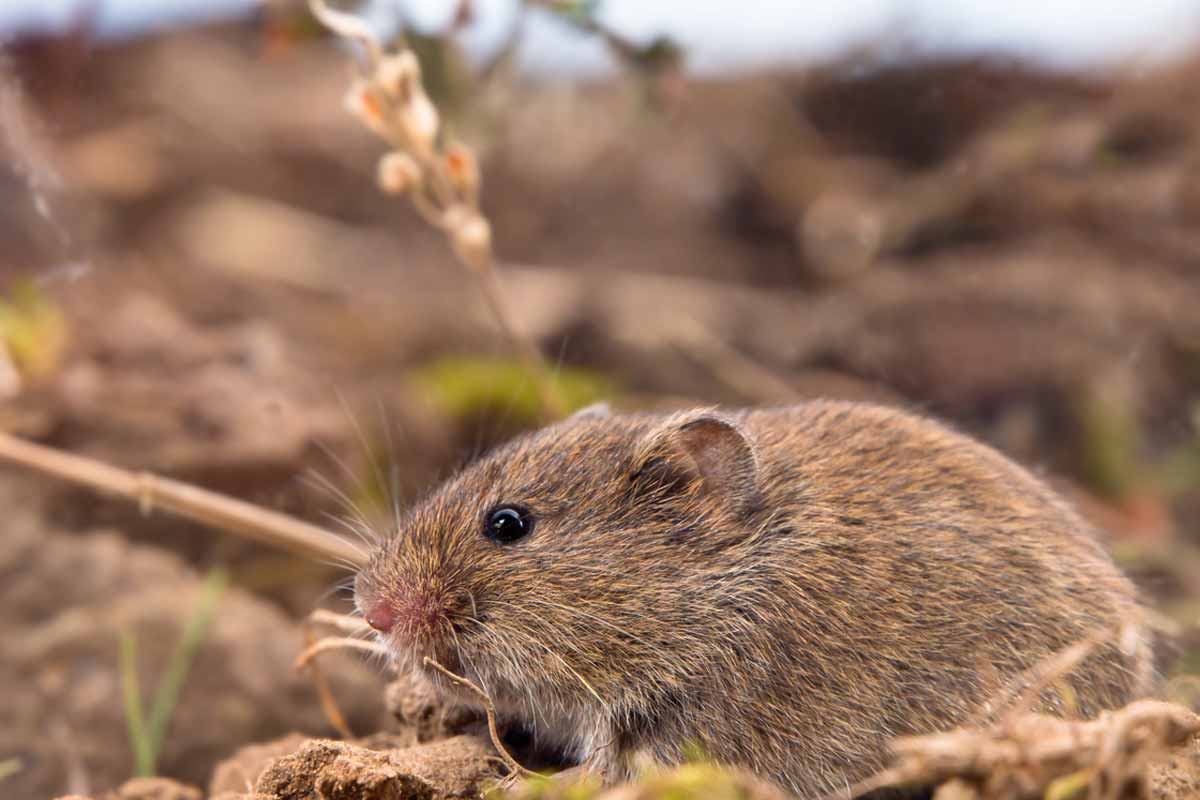
Should I Relocate This Animal?
For such a small animal, voles can cause big problems for homeowners. They can be especially worrisome since vole populations grow at an exponential pace, especially when they find areas with abundant resources. If you value a nice-looking yard and healthy trees, it might be prudent to take action earlier rather than later.
Risk Of Disease Or Injury
Voles are skittish creatures that will not harm humans unless cornered. Even then, these tiny animals can’t do too much damage, and vole bites are rare. However, in the case that a vole bites you, seek medical attention immediately, as these animals may carry diseases.
Cost
Trapping the voles will likely require buying some new equipment. If you have a large property, you will have to buy quite a few traps to start seeing a reduction in the population. Trapping may be costly, but it can help prevent more significant damage to your crops or lawn.
Ecological Benefits
Like other rodents that bury food for winter, voles spread seeds and increase plant diversity. They also aerate the soil and provide food for larger animals. That said, they can decimate plant life if their populations grow too large, so you’ll want to weigh the costs and benefits.
Time
If you see one vole on your property, chances are there are many, many more. These social creatures live in groups and reproduce fast. That means that trapping all of them—or at least enough to make a dent—will take some time.
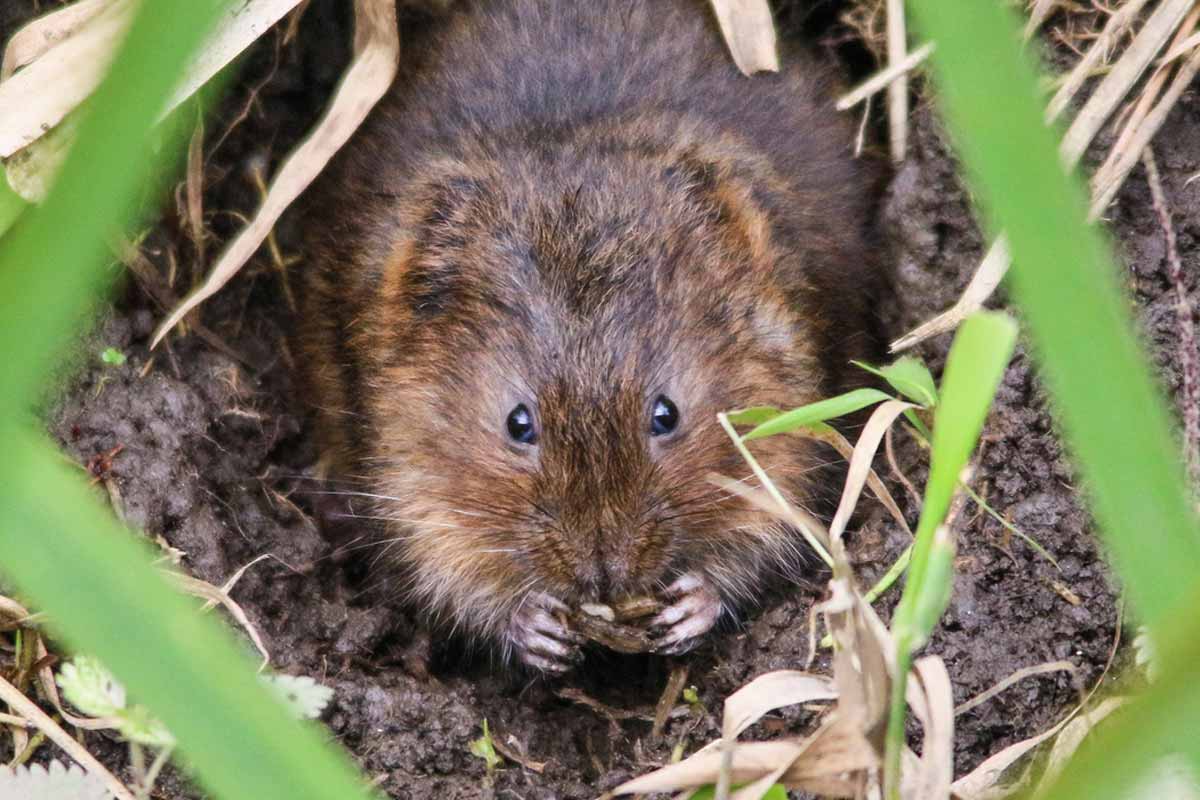
Treating Your Property For Voles
Since vole populations can balloon so quickly, you’ll want to take a proactive approach if you start seeing them—or the damage they cause—in your yard. If you prefer not to trap the voles, you can always deploy a store-bought treatment method. Many of these come in the form of a spray or granular repellents and do not harm the animals.
If you prefer to use natural methods to control your vole population, there are still plenty of other options. Voles, like many rodents, dislike some odors and can be driven out when confronted with them. Here are a few DIY treatment ideas to get you started.
Castor Oil
This handy oil works on most burrowing rodents. Plus, it’s an all-natural derivative of castor beans. You may even have some in your house already since it’s also used for moisturizing dry skin and reducing acne. Making a castor oil solution and spraying it around your garden may help deter voles.
Capsaicin
Voles dislike spicy-smelling foods, so you may be able to fend them off with hot spices from your cabinet. One ingredient that may be particularly helpful is capsaicin, an oil that comes from hot peppers.
Pet waste
Voles have many natural predators, including cats and dogs. That means you can cause their droppings to scare voles away. Sprinkle some pet urine on your yard and voles will smell it, even from a distance. You can also purchase urine granules from some of the vole’s wild predators, which might be even more effective.
Garlic
Most rodents dislike the overpowering scent of garlic, so placing it inside the vole tunnel may send them scurrying away. You can also experiment with other strong odors, like onions or fish.
Vole Problem?
Like other rodents that bury food for winter, voles spread seeds and increase plant diversity.
Gather The Tools You’ll Need
Leather Gloves
These will help prevent vole bites when you’re transferring the animal and protect you from exposing yourself to disease.
A Live-catch Trap
Experts recommend a small two-door trap that will let the rodent walk in but not exit.
Tarp
Protects your vehicle from animal waste during transport.
Blanket
Can be placed on top of the trap during transport to calm the scared animal.
How To Steps For DIY Removal
One of the essential steps in trapping your voles is figuring out their final destination. Since they’re often considered a nuisance for homeowners, you may want to find an undeveloped, wooded area where they won’t create problems. Make sure you obtain permission from the landowner before releasing your voles.
Live-trapping the voles
Step 1:First identify the runways. They will be one or two inches wide and cleared of vegetation.
Step 2: Place the trap along the length of the runway. Voles almost never veer from their runways, so they will likely walk right into it.
Step 3: Bait the trap if desired. Bait isn’t as effective with voles, but you can try to increase your odds of catching one by adding grass or a vegetable.
Step 4: Check the trap. Hopefully you’ve captured one or more voles.
Step 5: Transport to a new location and release.
Step 6: Repeat the process until you have resolved your vole issue.
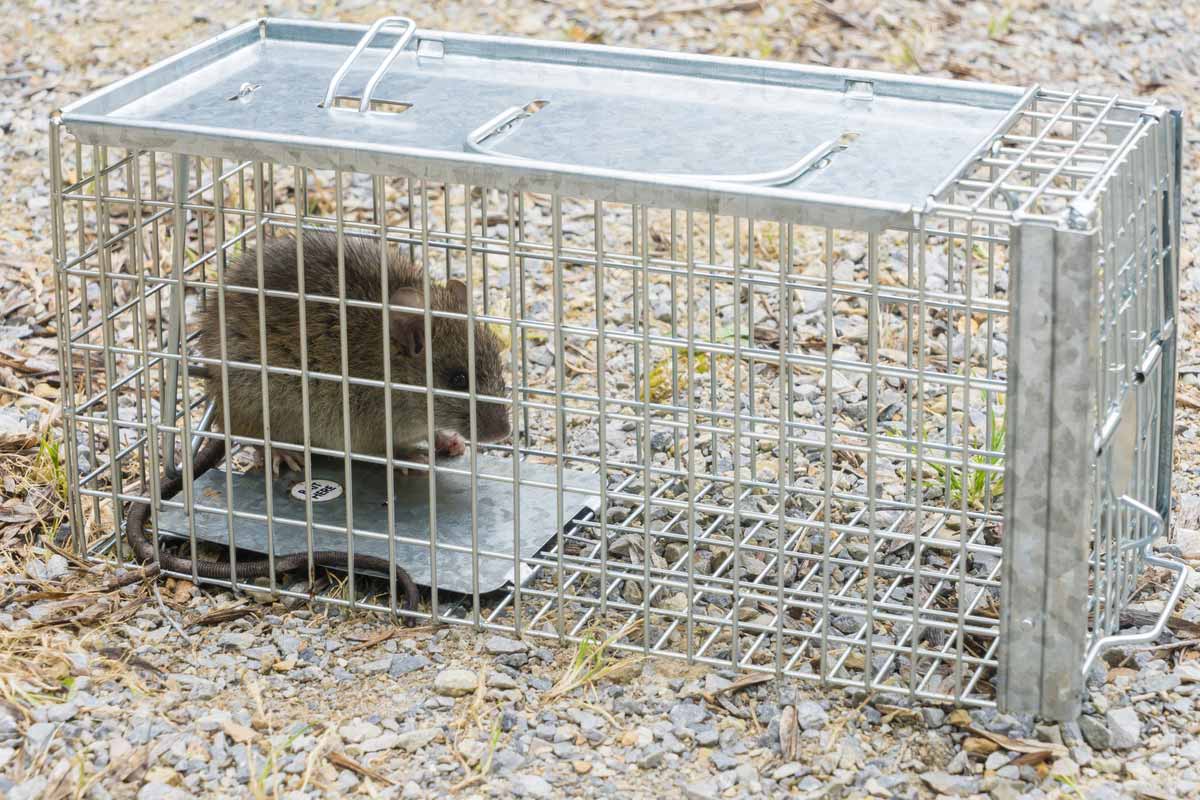
Voles are susceptible to ticks just like other rodents, and this means they can spread Lyme disease.
Risks Of Disease
Lyme disease:
Voles are susceptible to ticks just like other rodents, and this means they can spread Lyme disease. These ticks may also bite humans, so try to wear repellent and protect your skin when walking through a vole-infested territory. Also keep an eye out for a rash as well as other symptoms like fever, fatigue, and swollen lymph nodes.
Tularemia:
This bacteria can spread either directly, through the handling of an infected vole, or indirectly, through a tick or other parasite. Tularemia is highly infectious to humans and symptoms can take many different forms.
Babesiosis:
This is a condition caused by tiny parasites transmitted by tick bites. The parasites can attack red blood cells and cause anemia, as well as other flu-like symptoms. Ticks carried by voles and a few other rodents spread it.
Hemorrhagic Fever with Renal Syndrome:
This virus spreads by the bank vole, commonly found in Europe and Asia, as well as by other rodents. Humans can contract the virus by coming into contact with droppings or urine from the rodents. Keep an eye out for symptoms like severe headaches, fever, and nausea.
Rabies:
There are no reported cases of humans contracting rabies from voles. However, you should always avoid a wild animal that is acting out of character. Voles are usually cautious creatures so if one of them approaches you or acts aggressive, carefully avoid handling it.
Vole Sounds
Similar to mice, voles emit a high-pitched chirp when communicating with others, however, most of their vocal sounds are on a frequency beyond the human hearing capacity. Even while burrowing and rustling while foraging, most of their sounds are far too quiet for humans to hear.
Vole Tracks
The tracks that voles make aren’t so much actual track prints as they are the tunnels and burrows they create. Their ‘runways’ are most obvious in the spring and into the summer where you will see furrows with a lack of grass and a rise of top soil by two to three inches and an inch or two wide.
Vole Poop
Vole poop are usually greenish-colored pellets found near the burrow entrances, are roughly three-sixteenths of an inch long and often include grass clipping or foliage remnants. As they age, the dropping turn from green to brown or gray.
Prevent
If you’ve successfully rid your yard of voles, it’s time to move on to the next phase: preventing their return. Voles look for certain resources when choosing a home, but you can help make your yard less attractive to them with a few steps.

Prevention Methods
- Voles don’t like exploring above ground if they don’t have cover. Remove any yard debris that could act as a hiding place for voles.
- Cut your grass. Again, voles prefer to make their runways through high weeds and grasses where it’s easier to stay concealed. Keeping your lawn well trimmed will make it a riskier environment for them.
- Voles will resort to eating tree bark if other food is scarce, usually in the winter months. Since this “girdling” can kill the tree, you’ll need to protect it. Experts recommend covering the base of the tree trunk with fine metal mesh all the way up to the snow line. Denying voles this source of winter sustenance may force them off your property.
- Voles enjoy eating plant bulbs and roots from their underground tunnels. Adding some rocks to your garden bed may make it harder for them to access the food that they want.
- Avoid using mulch around your trees and ornamental plants. Voles may use the mulch as cover and be more — not less — likely to feed on them.
- Try surrounding your yard or garden with a mesh metal fence. Voles are not great climbers, so it will only need to be about one foot high (unless you’re trying to keep out other pests too). Just make sure the mesh is fine enough that voles can’t squeeze through, with holes that aren’t bigger than one-fourth of an inch.
Treating Your Property For Voles
Since vole populations can balloon so quickly, you’ll want to take a proactive approach if you start seeing them—or the damage they cause—in your yard. If you prefer not to trap the voles, you can always deploy a store-bought treatment method. Many of these come in the form of a spray or granular repellents and do not harm the animals.
If you prefer to use natural methods to control your vole population, there are still plenty of other options. Voles, like many rodents, dislike some odors and can be driven out when confronted with them. Here are a few DIY treatment ideas to get you started.
Castor Oil
This handy oil works on most burrowing rodents. Plus, it’s an all-natural derivative of castor beans. You may even have some in your house already since it’s also used for moisturizing dry skin and reducing acne. Making a castor oil solution and spraying it around your garden may help deter voles.
Capsaicin
Voles dislike spicy-smelling foods, so you may be able to fend them off with hot spices from your cabinet. One ingredient that may be particularly helpful is capsaicin, an oil that comes from hot peppers.
Pet waste
Voles have many natural predators, including cats and dogs. That means you can cause their droppings to scare voles away. Sprinkle some pet urine on your yard and voles will smell it, even from a distance. You can also purchase urine granules from some of the vole’s wild predators, which might be even more effective.
Garlic
Most rodents dislike the overpowering scent of garlic, so placing it inside the vole tunnel may send them scurrying away. You can also experiment with other strong odors, like onions or fish.
Vole Problem?
Vole Sounds
Similar to mice, voles emit a high-pitched chirp when communicating with others, however, most of their vocal sounds are on a frequency beyond the human hearing capacity. Even while burrowing and rustling while foraging, most of their sounds are far too quiet for humans to hear.
Vole Tracks
The tracks that voles make aren’t so much actual track prints as they are the tunnels and burrows they create. Their ‘runways’ are most obvious in the spring and into the summer where you will see furrows with a lack of grass and a rise of top soil by two to three inches and an inch or two wide.
Vole Poop
Vole poop are usually greenish-colored pellets found near the burrow entrances, are roughly three-sixteenths of an inch long and often include grass clipping or foliage remnants. As they age, the dropping turn from green to brown or gray.
When to Call a Professional
Vole populations have a natural ebb and flow, but when they peak, they can be challenging to manage. Weigh the pros and cons of using a DIY treatment method versus hiring a professional. If the vole population seems small, an expert may not be necessary. But if you feel overrun by these tiny critters and worry for your trees and plants, it may be time to call in an experienced pest control expert.
Sources
http://ipm.ucanr.edu/PMG/PESTNOTES/pn7439.html
https://extension.usu.edu/news_sections/gardening/vole-damage
https://www.smilinggardener.com/organic-pest-control/how-to-get-rid-of-moles-and-voles/
https://www.thespruce.com/vole-control-getting-rid-of-voles-2131148
https://www.cdc.gov/rodents/diseases/direct.html
https://www.cdc.gov/rodents/diseases/indirect.html
http://www.wildlifeanimalcontrol.com/voles.html
https://www.sanjoaquinpestcontrol.com/experienced-gardener-blog/common-signs-of-vole-damage-in-your-yard
https://northernwoodlands.org/outside_story/article/shrew-or-mole-mouse-or-vole
https://en.wikipedia.org/wiki/Vole
https://www3.northern.edu/natsource/MAMMALS/Prairi1.htm
https://www.arkive.org/meadow-vole/microtus-pennsylvanicus/
https://www.thespruce.com/vole-control-getting-rid-of-voles-2131148
Treating Your Property For Voles
Since vole populations can balloon so quickly, you’ll want to take a proactive approach if you start seeing them—or the damage they cause—in your yard. If you prefer not to trap the voles, you can always deploy a store-bought treatment method. Many of these come in the form of a spray or granular repellents and do not harm the animals.
If you prefer to use natural methods to control your vole population, there are still plenty of other options. Voles, like many rodents, dislike some odors and can be driven out when confronted with them. Here are a few DIY treatment ideas to get you started.
Castor Oil
This handy oil works on most burrowing rodents. Plus, it’s an all-natural derivative of castor beans. You may even have some in your house already since it’s also used for moisturizing dry skin and reducing acne. Making a castor oil solution and spraying it around your garden may help deter voles.
Capsaicin
Voles dislike spicy-smelling foods, so you may be able to fend them off with hot spices from your cabinet. One ingredient that may be particularly helpful is capsaicin, an oil that comes from hot peppers.
Pet waste
Voles have many natural predators, including cats and dogs. That means you can cause their droppings to scare voles away. Sprinkle some pet urine on your yard and voles will smell it, even from a distance. You can also purchase urine granules from some of the vole’s wild predators, which might be even more effective.
Garlic
Most rodents dislike the overpowering scent of garlic, so placing it inside the vole tunnel may send them scurrying away. You can also experiment with other strong odors, like onions or fish.
Vole Problem?
Sources
https://www.crittercontrol.com/services/voles/voles-sounds
https://www.nrem.iastate.edu/wildlife/vole-tracks-grass
http://ipm.ucanr.edu/PMG/PESTNOTES/pn7439.html
Vole Sounds
Similar to mice, voles emit a high-pitched chirp when communicating with others, however, most of their vocal sounds are on a frequency beyond the human hearing capacity. Even while burrowing and rustling while foraging, most of their sounds are far too quiet for humans to hear.
Vole Tracks
The tracks that voles make aren’t so much actual track prints as they are the tunnels and burrows they create. Their ‘runways’ are most obvious in the spring and into the summer where you will see furrows with a lack of grass and a rise of top soil by two to three inches and an inch or two wide.
Vole Poop
Vole poop are usually greenish-colored pellets found near the burrow entrances, are roughly three-sixteenths of an inch long and often include grass clipping or foliage remnants. As they age, the dropping turn from green to brown or gray.





